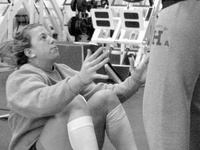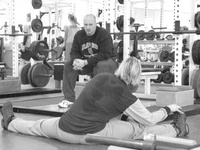The program was demanding, given that it required five days of running, three days of lifting and one day of long-distance running per week, which the women’s hockey players all maintained on top off full-time jobs. Though they had slightly different schedules, they tried to coordinate their arrivals.
“We managed to organize it so we would get their undivided attention,” Ingram said. “One of them would go out and take us through the whole [program]. I would have never thought we could have that experience.”
Hayes praised the dedication of those who worked out with him this summer.
“They knew what their overall goal was,” Hayes said. “They knew they had a chance to be this good. They worked that hard because they wanted to reach that potential.”
The hockey players enjoyed the program so much that they made t-shirts for themselves, Hayes and Nash to commemorate the experience. The front corner of the shirts said “Fat Camp 2002.” The shirts’ backs read “NICE RACK” in big letters—a tribute to the Murr Center weight racks.
“They love our kids—they love to have our kids come in because our kids will work hard and get in there,” Stone said.
Individual Attention
The strength and conditioning staff’s importance comes through in the most difficult of situations.
For example, Hagerman suffered a torn ACL early in her collegiate career, which greatly limited the kind of strengthening programs she could do on her own. For Hayes and Nash, Hagerman’s dysfunctional knee was only a challenge.
Hayes’ staff recommended balance and hamstring work to make sure Hagerman’s knee was stabilized—exercises he likes to call ‘prehab,’ to prevent injuries. Hagerman says the staff is constantly thinking of new ways to strengthen her knee so she can perform at the highest level.
“They stood by me in my decision to play and at the same time did everything in their power to make sure I was strong and stable so that I could help my team in any way possible,” Hagerman said.
Hagerman says, while knocking on wood, that her knee has felt better than it ever has since the injury.
“She’s one of the hardest workers on the team,” Hayes said. “She’s so goal-oriented that you just challenge her with something she’s going to do it.”
Thanks largely to conditioning, the women’s hockey team has escaped this season with just one long-term injury, and an unavoidable one at that. Ingram suffered a thumb fracture when she was hit into the boards by a Dartmouth player in November. The injury kept her off the ice for six weeks but not out of the weight room. Such an injury was just another challenge for Hayes.
“We’re able to develop a program for an injured athlete, because just because you have one injured limb on your body, you still have three healthy limbs,” he said. “You’ve got to train your body throughout your injury. That way when you’re ready to get back on the ice, you’re stronger than you were when you got injured.”
Read more in Sports
Every Student Picks Nicole














